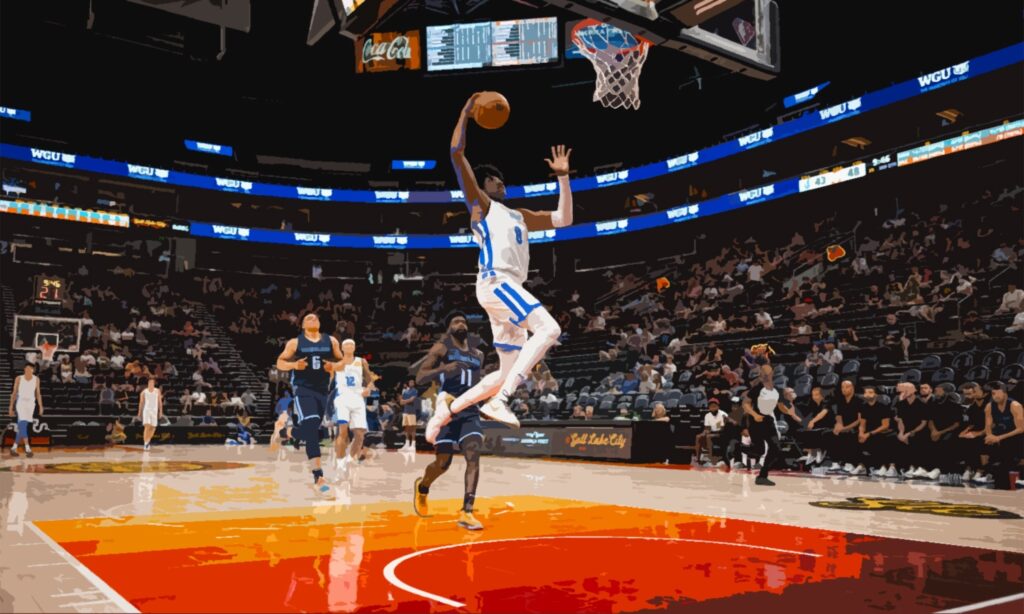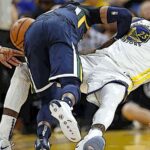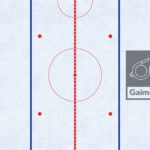The basketball court consists of various lines and markings which define the boundaries of the playing area.
The court is symmetrically divided into the offensive and defensive zones at the division line located midcourt.
During gameplay, fans will quickly become familiar with markings such as the free throw line, 3-point arc and the post area.
The free throw line is where players shoot uncontested shots following personal fouls, bonus situations or other violations.
The three-point line or “arc” is what separates a field goal resulting in a two-point or three-point bucket.
Note that in order for a three-point shot to hold, both players feet must be completely behind the line prior to shooting.
The post is the another noticeable area on the court, normally referred to players and announcers as the “paint”.
As you can imagine, there is an area on the court that is distinct in color.
So, let me explain…
What is the Post in Basketball?
In basketball, the post, also known as the “paint”, refers to the area between the baseline and the free throw line near the basket. It's a strategic zone where post players, often taller and more physical, operate to score using various moves and positioning. In addition to scoring, the post is crucial for rebounding and interior play.
And here is a picture to depict where the post is on the court.

Note that on the court, each team is made up of 5 players. The post players consist of the centres and power forwards.
The remaining positions is the shooting guard, point guard and small forward. They are collectively known as the perimeter players.
Post vs Perimeter Players
Post and perimeter players refer to two distinct player roles based on their positioning and primary areas of play on the court.
These roles play a crucial part in the overall strategy and gameplay of a basketball team.
Post Players
Post players, also known as "big men," are typically taller and stronger players who operate closer to the basket.
This area is particularly comprised of the low post area near the baseline and around the key.
Post players often play near the painted area, also referred to as the "paint" or "post," which is the rectangular region around the basket.
They are known for their ability to score close to the rim, use physicality to establish position, and grab offensive and defensive rebounds.
Post Player: Key characteristics
1. Scoring in the post: Post players use a variety of moves, such as drop steps, hook shots, and turnaround jumpers, to score in the paint.
2. Rebounding: Post players are vital for both offensive and defensive rebounding, helping their team secure possessions.
3. Shot-blocking: Their height and defensive skills make them effective shot-blockers and rim protectors.
Perimeter Players
Perimeter players, often referred to as "guards" and "wing players," operate on the outer edges of the court, away from the basket.
They play on the "perimeter" of the court and are known for their ball-handling, shooting, and playmaking abilities.
Perimeter players are typically smaller and more agile than post players.
Perimeter Player: Key characteristics (TABLE)
1. Ball-handling: they are usually in charge of bringing the ball up the court from the defensive to offensive end
2. Passing: they create scoring opportunities for their teammates
3. Shooting: They are often relied upon for their outside shooting, including three-pointers and mid-range jump shots.
4. Playmaking: They are the quarterback on offense, responsible for setting up the plays whether by initiating a pass, movement on the court or shooting
Overlap and Versatility
While post players and perimeter players have distinct roles, modern basketball has seen increased versatility among players.
Some players, known as "stretch bigs," have the ability to play both inside the paint and shoot from outside. Similarly, certain perimeter players possess the size and strength to contribute in the post.
This overlap highlights the evolving nature of player roles in basketball.
In essence, post players are known for their presence close to the basket, rebounding, and interior scoring.
While perimeter players excel in ball-handling, shooting, and playmaking from the outer edges of the court.
Post Shot Types
Since your standard post player is tall and even large physically, they have many techniques to score buckets.
We're talking hear about dunking, jamming, bank shots, hook shots and more.
I’ve included a list below describing the different shot options for post players.
List of Post Shots
| Shot Type | Description | |
|---|---|---|
| 1 | Hook Shot | The hook shot is a fundamental post move where the player uses a sweeping motion to release the ball with one hand while using the other hand to shield the defender. It can be performed with either hand and is effective for close-range scoring. |
| 2 | Turnaround Jump Shot | In this move, the post player catches the ball with their back to the basket, then pivots and jumps to face the hoop while shooting a jump shot. It's a versatile shot that can be used to shoot over shorter defenders. |
| 3 | Drop Step | The drop step is a move where the post player catches the ball in the post, takes a step toward the baseline (away from the defender), and then quickly spins to the middle for a shot. |
| 4 | Up-and-Under | This move involves faking a shot to one side, causing the defender to jump, and then quickly stepping around the defender and finishing with a shot on the other side of the basket. |
| 5 | Baby Hook | Similar to a hook shot, the baby hook is a one-handed shot taken with a shorter, softer motion, often used when the defender is closely guarding the player. |
| 6 | Fadeaway Jump Shot | While not exclusive to the post, some post players employ a fadeaway jump shot by jumping away from the defender and releasing the ball with a high arc. This shot can be difficult to block due to the distance created from the defender. |
| 7 | Jump Hook | This shot is a combination of a hook shot and a jump shot. The player jumps off one foot while simultaneously releasing a hook shot, which can be effective for scoring over taller defenders. |
| 8 | Bank Shot | The bank shot involves using the backboard to angle the ball into the basket. While not exclusive to the post, it can be useful for post players when they are in close proximity to the backboard. |
| 9 | Dunk/Jam | When the post player has a clear path to the basket, they may opt for a powerful dunk, utilizing their size and athleticism to score. |
| 10 | Putback | This is not a traditional post move, but it involves grabbing an offensive rebound and quickly putting the ball back into the basket, often using a layup or short shot. |
As a reminder, post players may even pass the ball when double-teamed or as an element of surprise.
The pass option was necessary even for post player greats such as Shaq, Kareem Abdul-Jabbar and Hakeem Olajuwon.
Final Thoughts
One thing I’ve noticed in the NBA is the relationship between player size/height and their skill level.
That is, the smaller the player is, the more talented they are required to be.
Not many players get drafted and make a career for themselves at under 6’0 feet.
If they do make it, you better believe they are fantastic at playmaking, shooting and extremely quick.
These players need to be able to shake off taller defenders and get shots off without constantly being pressured.
Allen Iverson was a master at that, and even just makes the cutoff of "short players” at 6’0.
As for your post players, the taller and larger they are, it is of lesser importance for them to be great distant shooters.
And agility is not all too common amongst large post players either.
Rather, they use their bodies to chip away at their defender and get closer to the rim. The goal is to make the easy bucket as often as they can.
Don’t get me wrong, the NBA had talented post player shooters such as Tim Duncan and Dirk Nowitzki.
But height and physicality are definite selling points to earn you a roster spot in the NBA.
Don’t take my word for it, check out the average height of a typical professional player.






